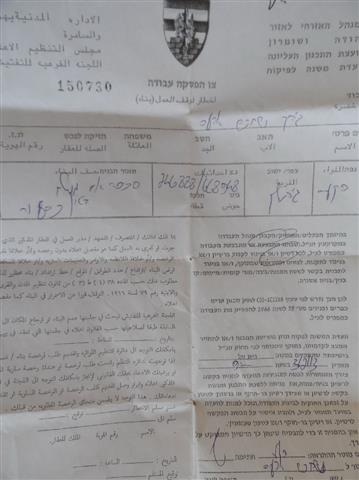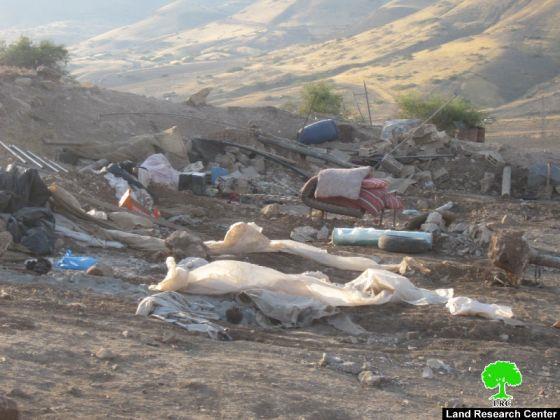"There is no choice: the Arabs must make room for the Jews of Eretz Israel. If it was possible to transfer the Baltic peoples, it is also possible to move the Palestinian Arabs."[1] former leader of the Zionist movement, Vladimir Jabotinsky, in a letter to one of his Revisionist colleagues in the United States dated November 1939.[2]
In the early morning of May 6, 2013, the Israeli occupation Authorities raided Al Jiftlik village, north of Jericho city, and handed over some Palestinian families in the area 6 notifications ordering them to stop the work at their houses and structures under the pretext of ‘lacking building permits’. The targeted Palestinian structures are located in area ‘C’, which is according to the Oslo II interim agreement of 1995 is subjected to the Israeli fully control (security and administration) and therefore, Palestinians living in area ‘C’ are obliged to acquire a building permit from the Israeli Civil Administration operating in the area and fulfill the Israeli requirements related to the aforementioned pretext in order to prevent their houses and structures from demolition and enables them to build in Area “C”. The targeted Palestinian structures belong to:
- Salem Ali Ka’abneh and his family – An 80-square meters brick house and a tin roof.
- Muhammad Musa Abu Arram and his family – 2 houses and an animal shelter. See Map 1
Map 1: location of targeted structures
Photo 1 & Photo 2: copy of some of the mlitray orders that were handed to Al Jiftlik villagers
Analysis:
An analysis conducted by the Applied Research Institute – Jerusalem (ARIJ) indicates that the targeted Palestinian structures are located adjacent to the illegal Israeli settlement of Maasu, one of the most agriculturally productive settlements in the Jordan valley.
Apparently, Israel plans to demolish the Palestinian structures located adjacent to the settlement’s border by claiming that they lack building permits from the Israeli Civil Administration while in fact, the settlements seeks to expand on the expense of the neighboring Palestinian lands and structures in Al Jiftlik village.
The successive Israeli governments, constantly, used this pretext (lack of building permits) to target Palestinian houses and structures in the Jordan Valley to implement its colonial plans by removing all the obstacles standing in its way, and Al Jiftlik village constitutes a strategic target for the Israeli occupation. Additionally, Israel considers the Jordan Valley, as Mr. Natanyahu proclaimed, the eastern defensive shield of Israel,[3] and so Israel is not willing to include it in any withdrawals from the West Bank in the future.
Previous Israeli Violations targeting Al JIftlik village in Jericho Governorate
Of course, this is not the first systematic Israeli attack towards Al Jiftlik village, where this village has witnessed many Israeli demolitions and evictions throughout the previous years, the last of which was On the 24th of November, 2010, and without any prior notifications, the Israeli Occupation Army and bulldozers raided Abu Al ‘Ajaj area in Al Jiftlik village in the northern parts of the Jordan Valley, and demolished three large Palestinian structures. As a result, a Palestinian family of 16 members, including 12 children has lost their shelter and became homeless.
Al Jiftlik village, general glance
Al Jiftlik village is located 33 km north of Jericho city. It’s bounded by the Israeli settlement of Argman from the east, the Israeli settlement of Mekhora from the west, the village of Jafa An Nun from the south, and an Israeli military base from the north. According to the Palestinian Central Bureau of Statistics (PCBS) the total population of Jiftlik village in 2013 is 4334 people.
The geopolitical status of Jiftlik village
According to the Oslo II interim agreement in 1995, between the Palestinian National Authority (PNA) and Israel, all lands of Al Jiftlek village were classified as area ‘C’, where Israel maintains full control over security and administrative matters. In area ‘C’ Palestinian building and land management is banned unless they obtain full consent from the Israeli Civil Administration. See table (1)
|
Table 1: The geopolitical division of Al Jiftlik village according to the Oslo II interim agreement in 1995
|
|
Area
|
Area in dunums
|
Percent of total village area
|
|
Area A
|
0
|
0
|
|
Area B
|
0
|
0
|
|
Area C
|
185,032
|
100
|
|
Total
|
185,032
|
100
|
|
Source: ARIJ-GIS unit – 2011
|
The impact of the Israeli occupation
Since the Israeli occupation of the West Bank in 1967, thousands of dunums were expropriated from Al Jiftlik village for the purpose of building settlements, outposts, military bases and constructing bypass roads to link the illegal Israeli settlements with each other. Currently, seven Israeli settlements occupy some of Al Jiftlik village lands and are inhabited by more than 2,800 Israeli settlers. Table (2) below gives more information about these illegal settlements:
| Table 2: The Israeli settlements constructed over Al Jiftlik lands |
| Settlement name |
Year of establishment |
Area confiscated in dunums |
Population of settlers (2011) |
| Massu’a |
1970 |
2,247 |
197 |
| Ma’ale Efraim |
1970 |
1,405 |
1,558 |
| Yafit |
1980 |
1,443 |
141 |
| Peza’el |
1972 |
187 |
303 |
| Gitit |
1973 |
506 |
315 |
| Mekhora |
1973 |
467 |
136 |
| Argman |
1970 |
614 |
185 |
| Total |
6869 |
2,835 |
| Source: ARIJ-GIS unit – 2013 |
Additionally, to assure the ‘full security’ for its settlers, and to guarantee their longer existence in the aforementioned settlements, Israel has allocated more than four thousand dunums of Al Jiftlik village lands for the establishment of military bases.
The Israeli government has also confiscated lands from Al Jiftlik village to open several bypass roads such as roads no.90, no.50, no. 505 and no.508. These roads will grant the Israeli settlers the freedom of movement between the settlements, outposts and military bases nearby, but, of course, at the expense of the Palestinian communities in that area.
To conclude
The displacement and the expulsion of the Palestinians is still a major policy of the Israeli occupation to achieve its colonial enterprises in the occupied state of Palestine. However, these actions have been condemned by the International law and all human rights conventions, some of which are listed below:
- Article 53 & 147 of the Fourth Geneva Convention of 1949 indicated that: Extensive destruction and appropriation of property not justified by military necessity and carried out unlawfully and wantonly, is a grave breach of the Convention.
- ‘Article 12’ of the International Covenant on Civil and Political Rights Everyone lawfully within the territory of a State shall, within that territory, have the right to liberty of movement and freedom to choose his residence.
- Art. 23 of the Hague Convention of 1907 also provides: In addition to the prohibitions provided by special Conventions, it is especially forbidden to destroy or seize the enemy’s property, unless such destruction or seizure be imperatively demanded by the necessities of war.
[3] On the 3rd of June 2005, the Prime Minister of Israel, Benjamin Netanyahu declared that “the Jordan valley will never be included in any Israeli withdrawals. This Jordan Valley will stay under the Israeli control forever. It’s the eastern defensive shield of Israel. We will not return to the ‘67’ borders, which were indefensible. (Israeli National News, June 2005)

















